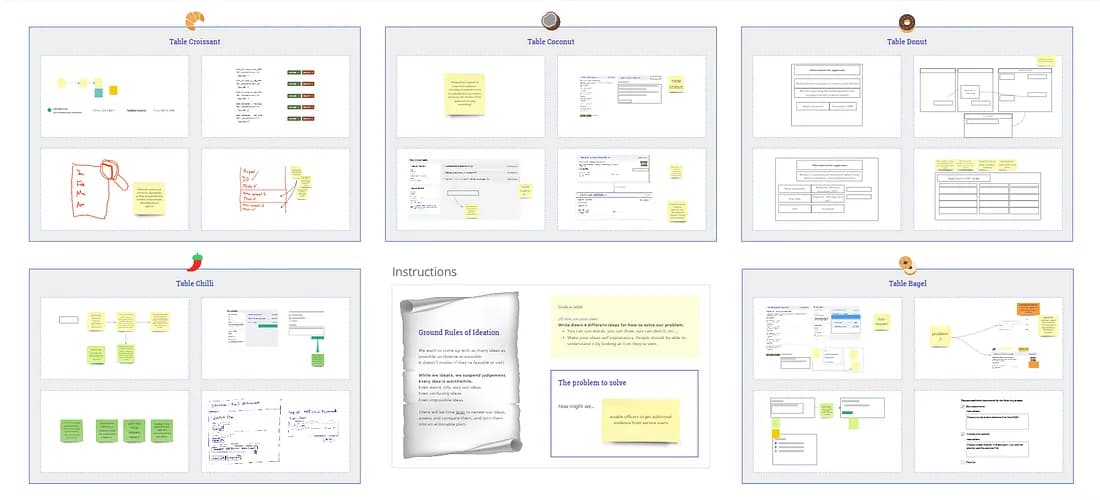Collaborative ideation
Goals
- Get your team unstuck when they're facing a tough problem and can't see a way forward
- Boost creativity and innovation in your team with a fun and inclusive activity
- Explore a wide and diverse range of options before making a decision
What you need
- paper, pencils, markers, etc
- a virtual whiteboard if you're running this remotely

Preparation
- Set up a creative space for your team. If you’re facilitating the session in person, make sure people have access to the material they need to ideate (paper, pencils, markers, etc…) If you’re working remotely, you can use this ready-to-go Miro template for collaborative ideation.
- Prepare the problem statement that you will use in the session as a prompt for ideation. Use an “How might we” question to make sure that your statement is focused on outcomes and does not suggest solutions.
- Share the statement with your team in advance and open the session by checking that everyone understands and agrees with it. Take a few minutes to tweak it together if necessary.
Some examples of problem statements:
- “How might we enable users to discover new artists they might like?” to come up with new features in a music streaming app
- “How might we create a memorable and impactful brand experience at industry events?” to spur new ideas in a marketing team
- “How might we shorten delivery times?” to find ways to improve processes in order fulfilment
Set the scene
Introduce the aim and rules for the session:
- We are here to come up with ideas to solve the stated problem
- We all agree to follow the ground rules of ideation:
We want to come up with as many ideas as possible, as diverse as possible.
At this point, it doesn’t matter if they are feasible or not!While we are ideating, we suspend judgement. Every idea is worthwhile.
Even weird, silly, way-out ideas
Even confusing ideas
Even impossible ideas
There will be time later to review our ideas, assess and compare them, and turn them into an actionable plan.
Ideate
Set a comfortable timeframe for everyone to ideate on their own (I like to use at least 20 minutes)
Let participants know that they can use the medium they want: drawings, sketches, storyboards, wireframes, words, etc… Advise them to make their ideas as self explanatory as possible, so that you’re all able to look at them after the session and understand what they are about.
Ask everyone to get the material they need: paper, pencils, markers, phone to take pics, whatever creative app people want to use, etc…
If you are using the Miro template, ask participants to grab a ‘table’ on the board. When everyone is ready, start the clock and let people get in the creative zone.
You’ll be surprised by the variety and creativity of ideas on the table when the timer ends!
What’s next?
What you do after that initial brainstorming is up to you and will depend on your needs, time available, complexity of the problem, etc…
Here are potential next steps that you can either action immediately or in follow-up sessions, with time for clean up, feedback and reflection in between:
Keep ideating
You can build onto the first round of ideas with either of these moves. Make sure you remind the group that judgement is still suspended as long as ideation is going!
- Set another timer to 10 min. Ask participant to pass their ideas around to the next person in the group (If you’re using the Miro template, ask people to move around to the next table clockwise). They now have to add two new ideas to the set of ideas they have just inherited.
- Use the 1–2–4 liberating structure. After the first round of solo brainstorming, ask people to pair up and come up with more ideas together, taking inspiration from their combined ideas and letting fresh new ones emerge. Repeat with groups of 4.
Share ideas
Bring everyone back together to share their ideas. Instead of asking each person to talk through all their ideas at once, which could take ages depending on the size of the group and the number of ideas they’ve generated, consider using a round robin:
- Each participant shares one of their ideas, taking turns around the groups until all ideas have been shared
- Keep a lively pace and limit discussion to clarifying questions only
If you’re putting ideas up on a whiteboard, encourage people as they talk to group their idea with any similar one that’s already been shared. But be careful not to erase the variety and nuances among ideas with a level of grouping that is too broad or generic! Sometimes, creativity is in the details and you’ll want to skip grouping.
Converge
Now you’re finally ready to restore judgement and decide which ideas to move forward. Stay tuned for converging techniques from Of Many Minds!